|
HealthWatch |
Compiled and coordinated by Edward
Arambewala |
With husbands in delivery rooms:
Better parents and better children
Up to now, as a policy Sri Lanka has not permitted officially for
husbands to be with their wives at delivery in delivery rooms in the
State hospitals but in the Castle Street Maternity Hospital in Colombo
where this has been permitted on trial basis for a few years from
1996-70 by its then director Dr. L.A.W. Sirisena to find its beneficial
effects on the family as it is happening in the developed world has
proved that it results in the same outcome of good parenting, good
children and happy homes to the society.
|
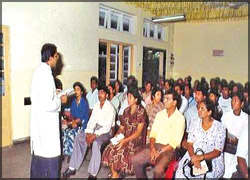
Doctor talks to husbands and wives |
|

Mapiya Sumithuro meeting in progress |
|
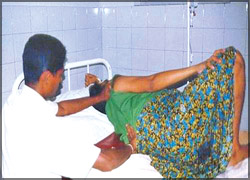
Husband comforting wife at delivery |
|
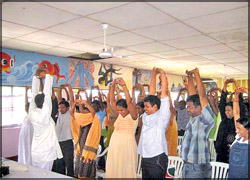
Husbands and wives exercising |
|
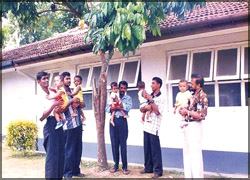
Husbands at delivery with their babies |
|

More exercise sessions |
Dr. Sirisena in an interview with the Healthcare on last week said,
that this project he initiated had interested the parents who came to
Castle Street Hospital.
So much that they had formed an association called “Ma piya sumithuro
- friendly parents” to promote this project, and get the Health Ministry
to officially approve it, so that it will go to all Maternity hospitals
in the country.
Dr. Sirisena said, the Minister had taken this up and had made a
statement at a function held in the Southern Province, that he would
shortly issue a circular to all maternity hospitals permitting them to
allow husbands to be in the delivery rooms of their wives. Dr. Sirisena
said this would bring Sri Lanka’s maternity services on par with
services in developed countries in the world UK, USA, etc in this
respect.
He said in respect of maternal mortality Sri Lanka is on top in
having the least death rate in countries in the South East Asian region.
Now for the main advantages of the husband’s presence in the delivery
suite;
1. Ensures mental balance of the labouring woman. Many a woman is
seen crying out in labour; this is not due to the pain alone, but mainly
due to fear of a situation not experienced before. A medical attendant
on the spot may reassure her but what better person than her life’s
partner, whose presence will allay fear and anxiety and make her better
prepared for the oncoming delivery.
A frightened and anxious woman is not likely to produce the best
uterine contraction needed to push the baby out; this depends on the
release of a hormone from the Hypothalamo-Pituitary axis which is
invariably influenced by her emotional state.
Thus the presence of the husband, by ensuring her emotional
well-being would most likely bring about an enhancing effect on the
process of labour, a welcome situation for all parties concerned.
The husband who is on the spot sees the hive of activity that goes on
in the labour ward and would see for himself with what diligence the
staff looks after his wife. This would not only result in appreciation
of the rendered services but also avoid unnecessary petitioning and
allegations of neglect or misconduct.
Both the husband and wife would be able to share the joy of the
birth, and if the traditional cup of coffee given to the mother is given
to the husband too, then they could enjoy a few moments of supreme joy
in their lives, sipping the coffee together.
An unforgettable experience of this nature would give them fresh hope
and added strength to their bonds of matrimony and shared life as equal
partners, both in private and public life. Thus we can surmise the many
advantages of enlisting the support of the husband by inviting him into
the clinics, counselling sessions and be a helpful partner during
delivery.
This is likely to have a snowballing effect on the very fabric of our
society resulting in good parents, good children, a pleasant home, a
conducive society, and a pleasant, conducive New Land!
##########################################
Food allergy uncommon
Itching skin, difficulty breathing, a runny nose and nausea. These
are just some of the symptoms that can be caused by food allergies. Yet
in most people, these symptoms are due to something else.
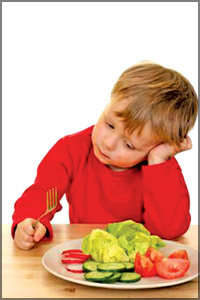 Allergies to substances other than foods are far more common than
food allergies. Studies show that approximately one in three adults
believe they have a food allergy. The reality is that true food allergy
affects only one to two per cent of adults and four to six per cent of
children. Allergies to substances other than foods are far more common than
food allergies. Studies show that approximately one in three adults
believe they have a food allergy. The reality is that true food allergy
affects only one to two per cent of adults and four to six per cent of
children.
People tend to diagnose themselves believing they have allergic
reactions to certain foods or food ingredients. Unfortunately
self-diagnosis of food allergy often leads to unnecessary food
restrictions and could lead to nutrient deficiencies especially in
children.
What is a food allergy?
A food allergy is an adverse reaction to a food or food component
that involves the body’s immune system. The immune system produces large
amounts of antibodies to fight against even small amounts of the food or
food component that the body is allergic to (the allergen).
This in turn produces histamine and other chemicals that cause
symptoms such as a dripping nose, itchy eyes, dry throat, rashes and
hives, nausea and diarrhoea.
Is it really an allergy?
True food allergy is quite uncommon, affecting only one to two per
cent of adults and four to six per cent of children. Common symptoms of
a true food allergy include:
* Hives, itching, a rash or eczema
* Swelling of the lips, face, tongue or other parts of the body
* Wheezing, breathing difficulties or a stuffy nose
* Stomach pain, diarrhoea, nausea or vomiting
* Dizziness, lightheadedness or fainting
* In severe reactions, shock, rapid pulse, a severe drop in blood
pressure and loss of consciousness may occur.
What foods can trigger food allergy?
The most common causes of food allergy, accounting for 90 per cent of
all food allergies are:
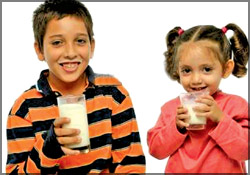
* Cow’s milk
* Wheat
* Egg whites
* Soybeans
* Peanuts
Other common causes are fish, shellfish, tree nuts, beans and corn.
What are the risk factors for developing food allergies?
There are several factors that increase the risk of developing a food
allergy.

These include:
Family history - if one of your parents has an allergy, you are twice
as likely to develop one.
Age - children are much more likely to have a food allergy than
adults are and most food allergies develop in people less than 30 years
of age. This is because the digestive system matures with age.
Fortunately, most children outgrow their allergy by about age 6 although
allergies to nuts and shellfish are more likely to be lifelong.
Food intolerance:
The Copycat
A reaction to a food or food component is more likely to be a food
intolerance rather than a true food allergy. Food intolerances do not
normally involve the immune system but as they seem to trigger many of
the same symptoms, they are often mislabelled as “food allergies’.
|
Points to remember
* Food intolerance can occur
to naturally occurring food components such as salicylates and
amines in some fruits and vegetables, as well as to a few food
additives such as sulphites or yellow food colour, tartrazine.
* People with food intolerance
are usually sensitive to more than one food ingredient.
* The degree of reaction and
the time it takes for symptoms to occur after eating certain
foods or food components also vary between people.
* If you suspect you have a
food allergy or intolerance, the best way to identify the food
component responsible is to seek expert medical advice from a
doctor or qualified medical allergist. The offending food or
food component can then be avoided. People who suffer from a severe
reaction should wear an “alert” necklace or bracelet that notes this.
|
The most common symptoms of food intolerance include hives,
headaches, mouth ulcers, stomach pains and bowel irritation.
Common mistakes in food intolerance
Fresh and processed foods both contain a range of chemicals - some
naturally occurring and others added to the food for quality or food
safety reasons. It’s easy to be led astray and blame the wrong food for
an allergy or intolerance without realising that it’s something else in
the food that’s causing the problem.
The important thing to remember though is that most people consume a
wide variety of food additives and ingredients daily with only a very
small number being associated with adverse reactions.

Milk
Many people think that milk is bad for people with allergies
especially asthma. In fact, this is not usually the case. While some
people claim to feel better after cutting milk and milk products out of
their diet, it is more likely to be that they suffer from intolerance to
amines and they have cut out natural amines found in food such as tasty
cheeses.
True milk allergy is an allergic reaction to the protein components
of milk. People with milk allergy need to avoid all milk and milk
products. In children, the condition is often outgrown. Scientific
studies show that milk and milk products do not usually cause stuffy
noses and congestion.
Lactose Intolerance
A more common occurrence is lactose intolerance or an inability to
digest lactose. Lactose is the natural sugar found in milk and milk
products.
An enzyme, lactase, breaks down the lactose in milk into smaller
sugars so that it can be more readily digested. If lactose is not broken
down, it is fermented by “friendly” bacteria in the small intestine.
This can give rise to symptoms such as bloating, diarrhoea and
stomach-ache.
Lactose intolerance has been estimated to affect up to 80% of Asians,
however in most cases, small amounts of milk
and milk products can be tolerated by people with lactose intolerance
especially when they are taken as part of a mixed meal.
Dairy foods made with “friendly” bacterial cultures, such as
yoghurts, have most of their lactose broken down by the bacteria and are
generally well tolerated by people who are sensitive to lactose.
Many cheeses, especially aged cheeses such as Swiss and cheddar
cheeses, have much of the lactose removed and are a valuable source of
calcium.
Taking smaller amounts of milk at more frequent intervals and eating
milk products as part of a meal are also ways to help include
lactose-containing foods in the diets of people who have trouble
digesting lactose, ensuring that they get enough calcium in their diet.
Courtesy: Food Facts
##########################################
Dr. Usuf for Hamburg
 Dr. Mass R. Usuf left for Hamburg, Germany on an invitation to
participate in the inaugural international conference of Homoeopaths
Worldwide. Dr. Mass R. Usuf left for Hamburg, Germany on an invitation to
participate in the inaugural international conference of Homoeopaths
Worldwide.
Dr. Usuf has been the Country Co-ordinator for HM Suisse for over two
years in connection with the free homoeopathic medical camps conducted
by him and his team of four doctors in the tsunami affected east coast
of Sri Lanka where over 20,000 patients have been treated in two years
of post-tsunami operations.
After the Hamburg conference he will head the operations of Natural
Medicare Sri Lanka which is a Swiss initiative to provide homoeopathic
assistance to Sri Lanka.
Dr. Usuf holds a PhD in Palm Diagnosis, deemed to be a first in the
world, besides an MD in Acupuncture. He is also a Member of the
Foundation for Homoeopathy (Medicina Alternativa) and is also proficient
in Magnet therapy, Crymotherapy, Cupping therapy, Uropathy and
Bio-chemic medicine.
###########################################
New research links lowfat milk to lower risk for heart disease
Grabbing as little as one glass of lowfat or fat free milk could help
protect your heart, according to a new study published Thursday in the
American Journal of Clinical Nutrition.
Researchers found that adults who had at least one serving of lowfat
milk or milk products each day had 37 percent lower odds of poor kidney
function linked to heart disease compared to those who drank little or
no lowfat milk.
To determine heart disease risk, researchers from several
universities in the United States and Norway measured the kidney function of more than 5,000 older adults ages 45 to 84. They tracked
eating patterns and tested albumin-to-creatinine ratio ( ACR) — a
measure that when too low, can indicate poor kidney function and an
extremely high risk for cardiovascular disease.
function of more than 5,000 older adults ages 45 to 84. They tracked
eating patterns and tested albumin-to-creatinine ratio ( ACR) — a
measure that when too low, can indicate poor kidney function and an
extremely high risk for cardiovascular disease.
Researchers found that people who reported consuming more lowfat milk
and milk products had lower ACR, or healthier kidney function. In fact,
lowfat milk and milk products was the only food group evaluated that on
its own, was significantly linked to a reduced risk for kidney
dysfunction.
The study authors cited other research suggesting milk protein,
vitamin D, magnesium and calcium may contribute to milk’s potential
heart health benefits.
An overall healthy diet, including lowfat milk and milk products,
whole grains, fruits and vegetables was also associated with a benefit —
20 percent lower ACR or healthier kidney function. -Xinhua |

